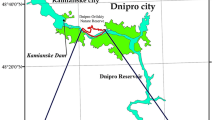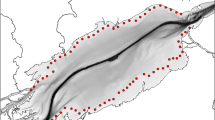Abstract
How the distribution and abundance of organisms vary across environmental gradients can reveal factors important in structuring aquatic communities. We sampled the littoral-zone fish community in a large reservoir (Lake Texoma) on the Texas–Oklahoma (U.S.A.) border that has pronounced environmental gradients from up- to downlake and between major tributary arms. Our objective was to evaluate the predictability of the littoral-zone fish-community structure from a suite of environmental variables. A stepwise multiple-regression model, with environmental factors at independent variables, explained 64% of the variation in fish species richness across sample sites. The number of species was positively associated with water-column productivity and total Kjedahl nitrogen, and negatively associated with Secchi depth and benthic productivity. Canonical correspondence analysis, with environmental factors as independent variables, explained 63% of the variation in fish-community structure across sites. Equal proportions of the variation in community structure were explained by variables that have strong gradients within the reservoir (e.g., Secchi depth and water-column productivity) and those that represent local habitat variables (e.g., shoreline aspect and substrate type).
Similar content being viewed by others
References cited
American Public Health Association, American Water Works Association, and Water Pollution Control Federation.1985. Standard methods for the examination of water and wastewater, 16th ed., Washington, D.C.
Angermeier, P.L. & R.A. Smogor.1995. Estimating number of species and relative abundances in stream-fish communities: effects of sampling effort and discontinuous spatial distributions. Can. J. Fish. Aquat. Sci. 52: 936–949.
Borcard, D., P. Legendre & P. Drapeau.1992. Partialling out the spatial component of ecological variation. Ecology 73: 1045–1055.
Coutant, C.C.1985. Striped bass, temperature, and dissolved oxygen: a speculative hypothesis for environmental risk. Trans. Amer. Fish. Soc. 114: 31–61.
Dendy, J.S.1946. Further studies of depth distribution of fish, Norris Reservoir, Tennessee. J. Tenn. Acad. Sci. 21: 94–102.
Fernando, C.H. & J. Holčík.1991. Fish in reservoirs. Internationale Revue der gesamten Hydrobiologie 76: 149–167.
Gelwick, F.P. & W.J. Matthews.1990. Temporal and spatial patterns in littoral-zone fish assemblages of a reservoir (Lake Texoma, Oklahoma–Texas, U.S.A.). Env. Biol. Fish. 27: 107–120.
Gido, K.B., W.J. Matthews & W.C. Wolfinbarger. 2000. Longterm changes in a reservoir fish assemblage: stability in an unpredictable environment. Ecol. Appl. 10: 1517–1529.
Gido, K.B. & W.J. Matthews. 2000. Dynamics of the offshore fish assemblage in a southwestern reservoir (Lake Texoma, Oklahoma–Texas). Copeia 2000: 917–930.
Hargrave, C.W. 2000. Spatial and temporal variation in fish assemblages of the upper Red River after a summer drought. M.S. Thesis, University of Oklahoma, Norman. 102 pp.
Henderson, P.A.1985. An approach to the prediction of temperate freshwater fish communities. J. Fish Biol. 27(Suppl. A): 279–291.
Hill, M.O. & H.G. Gauch.1980. Detrended correspondence analysis, an improved ordination technique. Vegetatio 42: 47–58.
Holčík, J.1998. Lacustrine fishes and the trophic efficiency of lakes: prelude to the problem. Ital. J. Zool. 65: 411–414.
Holmgren, K. & M. Appelberg. 2000. Size structure of benthic freshwater fish communities in relation to environmental gradients. J. Fish Biol. 57: 1312–1330.
Jongman, R.H.G., C.J.F ter Braak & O.R.R. Van Tongeren.1995. Data analysis in community and landscape ecology. Cambridge University Press, New York. 299 pp.
Kennedy, R.H. & W.W. Walker.1990. Reservoir nutrient dynamics. pp. 109–132. In: K.W. Thornton, B.L. Kimmel & F.E. Payne (ed.) Reservoir Limnology: Ecological Perspectives, John Wiley & Sons, New York.
Kimmel, B.L., O.T. Lind & L.J. Paulson.1990. Reservoir ecosystems: conclusions and speculations. pp. 133–194. In: K.W. Thornton, B.L. Kimmel & F.E. Payne (ed.) Reservoir Limnology: Ecological Perspectives, John Wiley & Sons, New York.
Legendre, P. & P. Legendre.1998. Numerical ecology, 2nd ed., Elsevier Science, Amsterdam. 853 pp.
Lienesch, P.W. & W.J. Matthews. 2000. Daily fish and zooplankton abundance in the littoral zone of Lake Texoma, Oklahoma–Texas, in relation to abiotic variables. Env. Biol. Fish. 59: 271–283.
Lohr, S.C. & K.D. Fausch.1997. Multiscale analysis of natural variability in stream fish assemblages of a western Great Plains watershed. Copeia 1997: 706–724.
Matthews, W.J.1998. Patterns in freshwater fish ecology. Chapman and Hall, New York. 756 pp.
McComas, S.R. & R.W. Drenner.1982. Species replacement in a reservoir fish community: silverside feeding mechanics and competition. Can. J. Fish. Aquat. Sci. 39: 815–821.
Merritt, R.W. & K.W. Cummins (ed.).1996. An introduction to the aquatic insects of N.A., 3rd ed., Kendall/Hunt Publishing Co., Dubuque. 862 pp.
Nadirov, S.N. & L.K. Malinin.1997. Seasonal dynamics of fish distribution in the piedmont Mingechaur Reservoir. J. Ichthyol. 37: 288–293.
Noble, R.L.1986. Predator–prey interactions in reservoir communities. pp. 137–143. In: G.E. Hall & M.J. Van Den Ayvle (ed.) Reservoir Fisheries Management: Strategies for the 80's, American Fisheries Society, Bethesda.
Pennak, R.W.1989. Fresh-water invertebrates of the United States: Protozoa to Mollusca, 3rd ed., JohnWiley & Sons, New York. 628 pp.
Ploskey, G.R.1986. Management of the physical and chemical environment: effects of water-level changes on reservoir ecosystems, with implications for fisheries management. pp. 86–97. In: G.E. Hall & M.J. Van Den Ayvle (ed.) Reservoir Fisheries Management: Strategies for the 80's, American Fisheries Society, Bethesda.
Pratt, K.E., C.W. Hargrave & K.B. Gido. 2002. Rediscovery of Labidesthes sicculus (Atherinidae) in Lake Texoma (Oklahoma–Texas). Southwest. Nat. (in press).
Robison, H.W. & T.M. Buchanan.1988. Fishes of Arkansas. University of Arkansas Press, Fayetteville. 536 pp.
Siler, J.R., W.J. Foris & M.C. McInerny.1986. Spatial heterogeneity in fish parameters within a reservoir. pp. 122–136. In: G.E. Hall & M.J. Van Den Ayvle (ed.) Reservoir Fisheries Management: Strategies for the 80's, American Fisheries Society, Bethesda.
Sokal, R.R. & F.J. Rohlf.1995. Biometry, 3rd ed.,W.H. Freeman & Co., San Francisco. 887 pp.
ter Braak, C.J.F.1992. CANOCO – a FORTRAN program for canonical community ordination. Microcomputer Power, Ithaca. 95 pp.
ter Braak, C.J.F.1995. Ordination. pp. 91–173. In: R.H.G. Jongman, C.J.F. ter Braak & O.F.R. Van Tongeren (ed.) Data Analysis in Community and Landscape Ecology, Cambridge University Press, New York.
Thornton, K.W., B.L. Kimmel & F.E. Payne (ed.).1990. Reservoir limnology: ecological perspectives. John Wiley & Sons, New York. 246 pp.
Tonn, W.M. & J.J. Magnuson.1982. Patterns in the species composition and richness of fish assemblages in northernWisconsin lakes. Ecology 63: 1149–1166.
Vaughn, C.C. & C.M. Taylor. 2000. Macroecology of a host–parasite relationship. Ecography 23: 11–20.
Vanderpuye, C.J.1982. Further observation of the distribution and abundance of fish stocks in Volta Lake, Ghana. Fish. Res. 1: 319–343.
Author information
Authors and Affiliations
Rights and permissions
About this article
Cite this article
Gido, K.B., Hargrave, C.W., Matthews, W.J. et al. Structure of Littoral-zone Fish Communities in Relation to Habitat, Physical, and Chemical Gradients in a Southern Reservoir. Environmental Biology of Fishes 63, 253–263 (2002). https://doi.org/10.1023/A:1014359311188
Issue Date:
DOI: https://doi.org/10.1023/A:1014359311188




